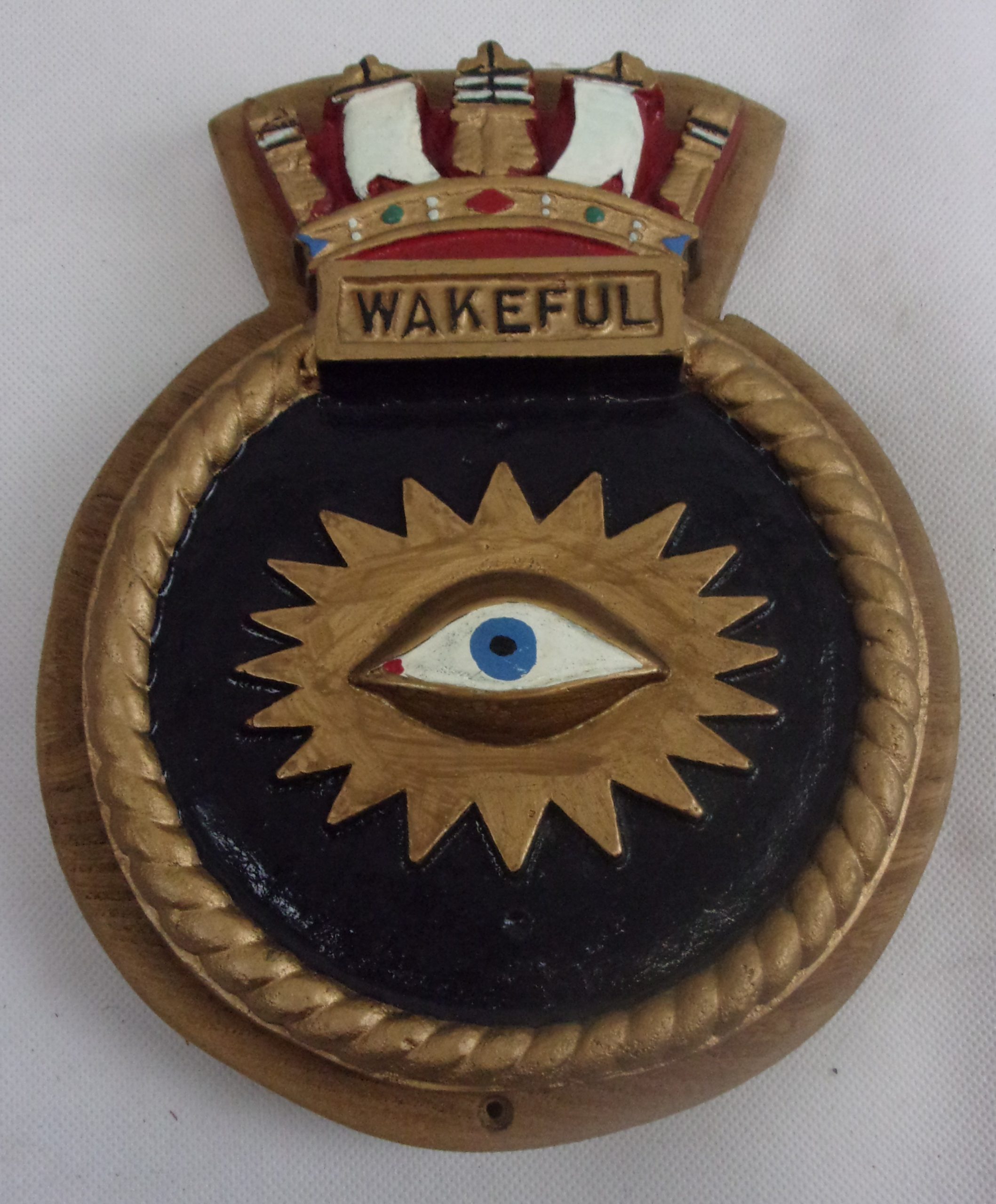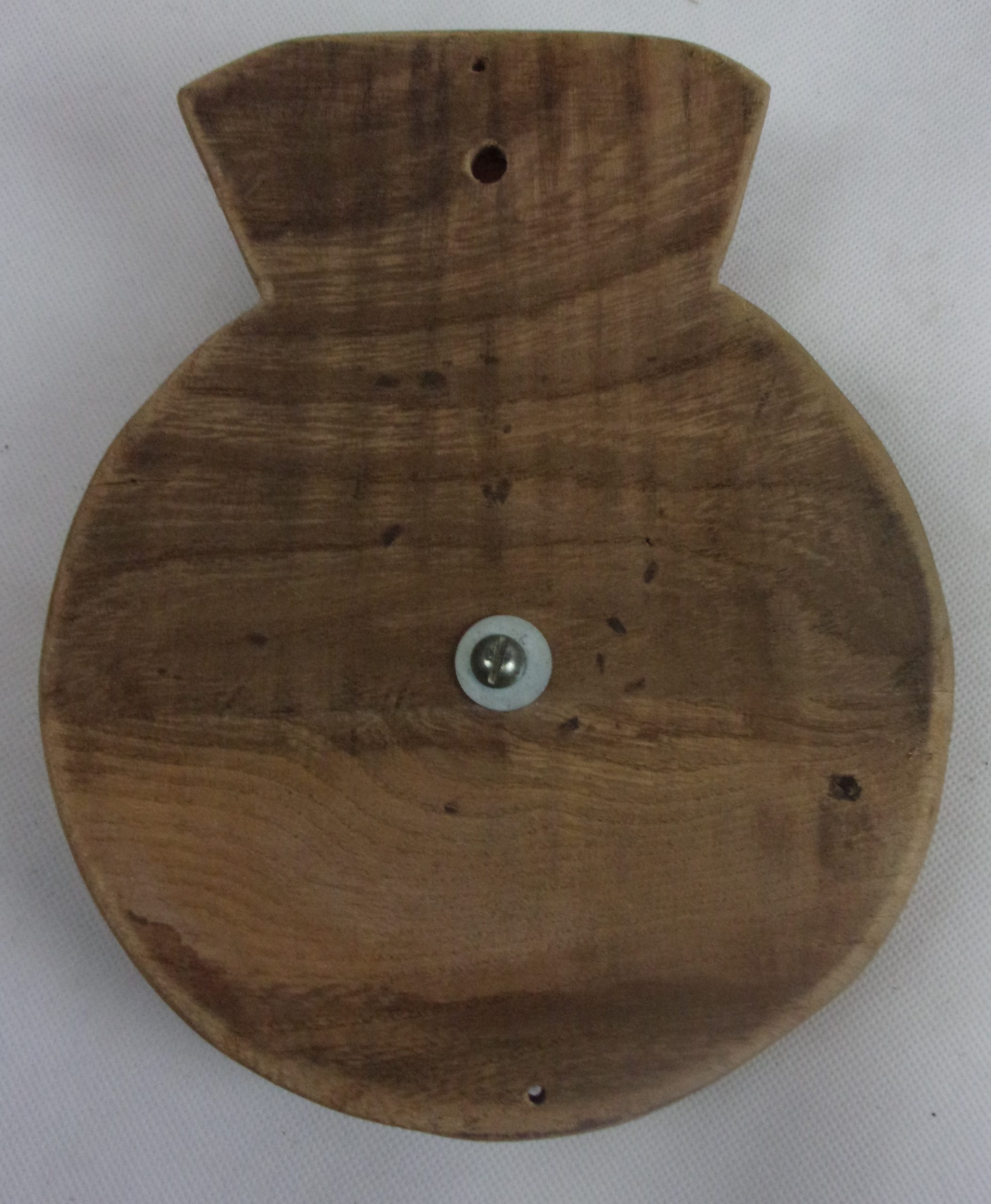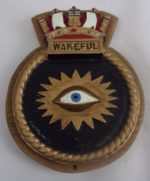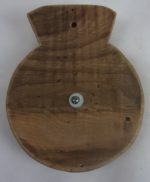~ HMS Wakeful Bronze 1944 Destroyer Boat Badge ~
An original bronze boat badge from the ship, now mounted on a later wooden board.
It bears the ship’s name and emblem of an open eye.
~ HMS Wakeful ~
HMS Wakeful was a W-class destroyer of the Royal Navy launched in 1943. She saw service during the Second World War and was later converted into a Type 15 fast anti-submarine frigate. She was sold for scrap in 1971.
HMS Wakeful was a W-class destroyer ordered from Fairfield Shipbuilding and Engineering Company, Govan, Glasgow on 3 December 1941 as part of the 9th Emergency Flotilla. She was laid down on 3 June 1942 under the provisional name of Zebra but was renamed Wakeful in January 1943, exchanging names with a destroyer also under construction, which was subsequently launched as HMS Zebra. She became the second ship of the name, the first being an Admiralty W-class destroyer sunk by a German E-Boat off Dunkirk in 1940 during Operation Dynamo, the evacuation from Dunkirk.
In January 1945 she took part in Operation Meridian One as an escort during air attacks on refineries at Pladjoe, and then took part in Operation Meridian Two as an escort during air raids on Soengi-Gerong near Palembang. In March 1945 the British Pacific Fleet joined Admiral Raymond Spruance’s United States Fifth Fleet, before joining Admiral William Halsey’s United States Third Fleet in May 1945. During August 1945 Wakeful was on escort duties during the Royal Navy and the United States Navy’s air raids on Hokkaido and North Honshū. The destroyer was in Tokyo Bay during the formal surrender and was available to support the occupation of Japan, remaining in Japanese waters to help with the repatriation of allied nationals before departing for Sydney. She returned to the UK in December 1945, having received the battle honors’ North Sea 1944′ and ‘East Indies 1944’ for her wartime service.
Between 1948 and 1950 her captain was Commander Royston Wright.
Wakeful was used as a Boys Training ship until she was converted to a Type 15 anti-submarine warfare frigate by Scotts Shipbuilding and Engineering Company between 1951 and 1953. In 1953 she took part in the Fleet Review to celebrate the Coronation of Queen Elizabeth II.
She was assigned the new pennant number F159 and served in the Mediterranean as a part of the 5th Frigate Squadron until 1957. During this time she took part in Operation Musketeer, the Anglo-French assault on Port Said to take control of the Suez Canal. In 1959 she recommissioned as leader of the Portsmouth Squadron, as a training tender to the Navigational Training School at HMS Dryad, and as trials ship to the Admiralty Surface Weapons Establishment (ASWE). On 25 February 1960, she was used for the burial at sea of Edwina Mountbatten, Countess Mountbatten of Burma off the coast of Portsmouth. On 25 August 1960, the destroyer Battleaxe was carrying out steam trials while moored alongside the minelayer Apollo at Portsmouth, when steam was let into the ship’s turbines, driving the ship forward and breaking Apollo’s mooring lines. Apollo then collided with Wakeful, which also broke free from her moorings and struck the caisson at the entrance to a dock. Apollo’s stem was damaged, while Wakeful suffered buckled plates from the impact by Apollo and a badly damaged bow from the collision with the caisson.
In April 1964 she was part of the 2nd Frigate Squadron and took part in ‘Navy Days’ in Portsmouth during that year. In the same year, Wakeful was used for the filming of the opening scenes of The Bedford Incident, including Sidney Poitier’s initial flypast and landing from a Whirlwind helicopter, when her pennant number F159 is clearly visible. (Some interior scenes were filmed in her sister Type 15 frigate Troubridge).
Between 1966 and 1967 she was fitted with experimental satellite communication equipment and stabilisers for trials. In 1968 she took part in ‘Navy Days’ at Portsmouth Dockyard and at this time was part of the 2nd Frigate Squadron. On 31 October 1967, she escorted the RMS Queen Mary out of Southampton on her final voyage to Long Beach for retirement. HMS Wakeful (Commanded by Lt.Cdr.David Whitehead) also went up the Ouistreham Canal for the 25th Anniversary of D Day in June 1969. Later that year she was replaced by Grenville. and Lieutenant Commander David Whitehead was transferred to HMS Grenville as her new commanding officer at this time.
In 1970 Wakeful was put on the Disposal List, and on 26 February left Portsmouth for de-equipping. She was sold to Thos W Ward for scrapping on 10 July 1971 and arrived in tow at Inverkeithing for demolition on 5 July that year.
~ Condition ~
The badge is in good order. It has been repainted.
~ Dimensions ~
The boat badge is 20 cm (8 inches) tall by 16 cm (6.25 inches) wide.
#9791





